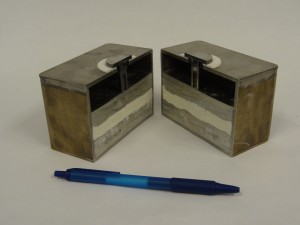Renewable energy has many benefits—global accessibility, scalability from home to national use, low carbon emissions, and virtually no limit on abundance. However, the oft-overlooked problem with renewable energy is how that energy is, or is not, being used. “The Grid,” our nationwide system of energy production and distribution, is intrinsically inefficient, regardless of the energy’s source. It is prone to over-production of energy that, when left unused, simply dissipates away, an unspoken waste on a massive scale.
Electrochemist Donald Sadoway, John F. Elliott Professor of Materials Chemistry at MIT, thinks the solution to the grid’s major inefficiencies is energy storage in the form of large batteries. Sadoway and his lab published a paper in Nature this September, presenting a surprisingly simple liquid metal battery that appears to be a groundbreaking first step towards feasible energy storage. Though still in the works, the battery has great promise for grid-wide use due to its relatively simple assembly, high voltage storage capacity, and projected low cost.

The proposed model consists of a liquid lithium negative electrode, a liquid antimony-lead alloy positive electrode, and a molten salt electrolyte in the middle — a straightforward electrochemical cell. However, the molten nature of the components is key, allowing them to “self-segregate [by density] into three distinct layers [and] confer the advantages of higher current density, longer cycle life, and simpler manufacturing,” according to Professor Kurt Zilm of the Yale Chemistry Department. Essentially, the molten design gives the battery a higher energy capacity and makes it unusually low-maintenance.
Early on, Sadoway began studying the electrolytic process used to smelt aluminum. This process resembles a giant battery, with an anode, a cathode, and a current that causes dissolved aluminum ions to reduce to aluminum metal. Aluminum smelting is also notable because it requires a huge amount of energy. Looking at this process, Sadoway began to ask himself, “Is there any way we could teach this thing not just to consume electricity but then store it and give it back on demand?”
As Sadoway’s lab worked to create a viable battery, they began with a magnesium-antimony composition. However, this battery had only moderate round-trip efficiency (the amount of electricity conserved during a given cycle). It also required a high operating temperature to keep the metals molten, and had a net component cost of about $375 per kilowatt hour, making it impractical for commercial use.
The current lithium-antimony-lead model, however, improved on all these fronts. Voltage discharge, the quantity of electricity the battery could take in and put out, increased threefold from the original model. Furthermore, the amount of storage capacity lost in each cycle allowed Sadoway’s team to project that the battery would retain 85 percent of its original energy storage capacity after 10 years. Perhaps most notably, the price dropped fivefold to $65 per kilowatt hour, making it an economically viable system. Sadoway’s lab has continued to improve the model since these early results. After tightening synthesis requirements, the projected ten-year energy storage capacity retention rose to 99 percent, a massive leap in longevity and, therefore, feasibility.
To start implementing this product, Sadoway and his lab created the company Ambri, which hopes to release its first batteries by 2016. One of the most promising uses seems to be with intermittent renewable energy sources like solar and wind power. Battery use would allow for energy storage during high-input periods when there is abundant sun and wind, which could then be distributed when demand is high or input is low. As Sadoway asserted, “Storage is the key to sustainability. The surprise was how well this thing worked. I guess, in my own unconfident fashion, maybe I really did make a discovery here.” It is impossible to know which technologies will catch on, but Sadoway sees immense potential in his design. If it were to be successfully and widely implemented, this discovery could portend a massive shift in the global energy economy, for the better.
